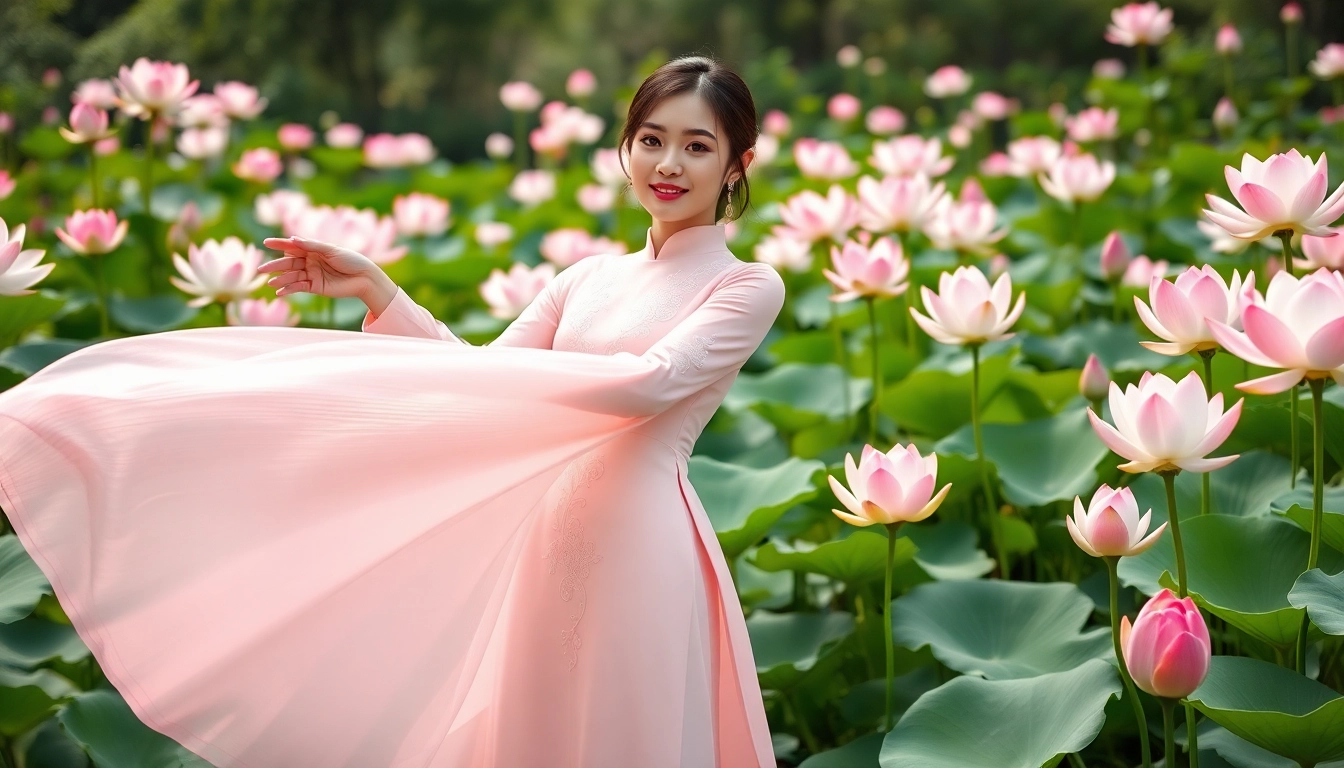
Understanding the Elegance of Vietnamese Áo Dài: Tradition and Fashion in Harmony
The Cultural Significance of Vietnamese Áo Dài
Historical Background
The Vietnamese Áo Dài, a traditional garment characterized by its elegance and modesty, has a long and rich history that dates back several centuries. Its origins trace back to the 18th century during the reign of the Nguyễn Dynasty, where it began as a simplified version of the Chinese dress called the “chai.” Initially worn by both men and women, the Áo Dài underwent several transformations, adapting to the cultural and aesthetic preferences of the Vietnamese people over time.
By the early 20th century, the Áo Dài took on its more recognizable form, especially among women. It became a symbol of Vietnamese identity, blending influences from French colonial fashion with traditional Vietnamese color and fabric choices. This shift reflected the social changes of the era, where women began to assert their independence while retaining their cultural heritage. The Vietnamese Áo Dài became distinct not only in style but also as a means of cultural expression in a rapidly changing world.
Symbolism in Vietnamese Identity
The Áo Dài is more than just a piece of clothing; it embodies the Vietnamese spirit and national pride. In many social and cultural contexts, the Áo Dài symbolizes femininity, grace, and traditional values. Its sleek and form-fitting silhouette accentuates the wearer’s elegance, making it a favored choice for occasions ranging from weddings to national celebrations.
Moreover, the color of the Áo Dài often holds special meanings. For instance, red is commonly worn during lunar new year celebrations as it symbolizes luck and prosperity, while white is preferred for funerals, symbolizing mourning and respect. As such, the Áo Dài plays a pivotal role in not just personal expression, but also in the socio-cultural tapestry of Vietnam, representing the connection between events and collective identity.
Regional Variations of Áo Dài
Across Vietnam’s diverse regions, the Áo Dài exhibits a variety of designs, patterns, and colors, influenced by local customs, climates, and artistic traditions. In the north, traditional designs often feature intricate embroidery and lighter fabrics suitable for the cooler climate. Regionally, the styles may encompass elements such as more conservative cuts and muted tones.
Conversely, southern regions, particularly cities like Ho Chi Minh City, showcase bolder colors and patterns, reflecting the vibrance of the tropical climate. Here, the designs often incorporate floral patterns and vivid hues, appealing to the modern flair of contemporary trends while honoring tradition. This regional diversity enriches the cultural significance of the Áo Dài, illustrating how local resources and aesthetics shape national identity.
Traditional Vietnamese Áo Dài Styles
Classic Designs and Modern Interpretations
Classic Áo Dài styles are synonymous with simplicity and elegance. Traditionally, the design features long sleeves and a long tunic that flares from the waist, allowing ease of movement without sacrificing modesty. As fashion evolves, designers have begun to reinterpret the classic styles to appeal to modern sensibilities. Innovations have included the incorporation of asymmetric cuts, unique collar designs, and varied lengths to suit different body types and personal preferences.
Today, fashion houses are experimenting with mixed materials, including silk, lace, and even denim. This blending not only showcases individualistic style but also keeps the traditional garment relevant. The result is a refreshing take on the Áo Dài that appeals to younger generations while honoring the traditional roots of the attire.
Materials Used in Áo Dài and Their Importance
The materials chosen for crafting an Áo Dài significantly influence its appearance and functionality. Traditionally, silk has been the fabric of choice due to its luxurious feel and visual appeal. However, other materials such as satin, brocade, and even cotton are often utilized for practicality and comfort, especially in different climates.
Color and pattern selection play equally important roles; the fabric’s sheen and texture can affect how colors are perceived. For instance, deep shades on silk can appear regal and sophisticated, while lighter fabrics may present a more casual aesthetic. This variety allows wearers to select Áo Dài that align with the occasion, personal style, and cultural significance.
Cultural Events and Festivals Featuring Áo Dài
The Áo Dài is prominently featured in Vietnamese cultural events and festivals. One of the most notable is Tết Nguyên Đán, the Vietnamese Lunar New Year, where wearing an Áo Dài symbolizes good luck and prosperity for the year ahead. Festivals celebrating the harvest and local heritage also see the Áo Dài adorning participants, emphasizing its role in communal identity and cultural heritage.
Besides traditional celebrations, the Áo Dài is gaining recognition on international platforms such as fashion weeks and cultural exhibitions, promoting Vietnamese heritage globally and fostering a deeper appreciation for its cultural significance.
How to Choose the Perfect Áo Dài for You
Understanding Fit and Fabric
Choosing the ideal Áo Dài starts with understanding fit and fabric. Traditional Áo Dài is designed to complement the wearer’s figure, enhancing natural curves while providing comfort. When selecting an Áo Dài, one should consider body shape and size; a well-fitted tunic should nip at the waist and flow gracefully to the hem. Seeking the expertise of a tailor can ensure that the garment is tailored to specific measurements, improving both comfort and aesthetics.
In terms of fabric, opting for breathable materials like silk or cotton is advisable for warm climates, whereas heavier fabrics may be suitable for formal occasions in cooler weather. This careful selection contributes to the overall appearance and comfort of the outfit.
Choosing Colors and Patterns
When selecting colors and patterns for an Áo Dài, it is essential to consider personal style and the significance of colors within Vietnamese culture. Popular choices include vibrant reds and pinks for celebrations, serene greens for casual wear, and muted pastels for more formal events. Patterns can range from traditional floral motifs to contemporary graphic designs, allowing for self-expression while respecting cultural heritage.
Individuals should also consider their skin tone and how certain colors enhance it. This thoughtful approach to color selection can elevate the overall look while ensuring that the Áo Dài remains a meaningful part of one’s wardrobe.
Accessorizing Your Áo Dài
Accessories play a crucial role in completing the Áo Dài ensemble. Traditional accessories include conical hats, jewelry, and silk scarves, which add layers of sophistication and cultural depth. The choice of accessories should complement the design of the Áo Dài without overshadowing its elegance. For instance, simple pearl earrings can enhance a classic silk Áo Dài, whereas colorful bangles may brighten a more contemporary design.
Additionally, handbags can be selected for both function and style, ensuring they match the overall color scheme while being practical for the occasion. Overall, with proper accessorizing, the Áo Dài can transition seamlessly from formal to casual settings.
Caring for Your Vietnamese Áo Dài
Washing and Maintenance Tips
Proper care is essential for preserving the beauty and longevity of your Áo Dài. Silk, for instance, requires delicate handling. It is advisable to hand wash silk Áo Dài in cold water with mild detergent, avoiding wringing to prevent damage. For other fabrics, always refer to care labels for appropriate washing instructions.
Regular maintenance, such as ironing and steaming, is also crucial for keeping the garment looking fresh and crisp. When storing your Áo Dài, avoid folding it in ways that can create permanent creases, and consider using padded hangers or fabric covers to protect the fabric from dust and damage.
Storage Techniques for Longevity
Proper storage techniques can significantly extend the life of your Áo Dài. It is ideal to hang the garment in a cool, dry place away from direct sunlight, which can fade colors over time. Using breathable garment bags can protect the fabric from dust while allowing it to breathe.
For long-term storage, avoid using plastic covers as they can trap humidity, leading to mold and mildew. Instead, opt for cotton or muslin wraps that protect the garment while allowing air circulation.
Repairing and Altering Áo Dài
No matter how well-maintained, wear and tear can inevitably affect your Áo Dài. For minor repairs, such as loose seams or small rips, consulting a professional tailor is always recommended to ensure that repairs match the original craftsmanship.
Alterations may also be needed as body shapes change over time. Regular fittings can ensure that the Áo Dài remains flattering and comfortable. If the design is a newer interpretation, consider collaborating with modern seamstresses who can enhance the garment’s aesthetics while staying true to its traditional roots.
The Future of Vietnamese Áo Dài in Global Fashion
Influence of International Trends
The global fashion landscape continues to evolve, leading to the integration of traditional garments like the Áo Dài within contemporary styles. International designers are increasingly inspired by the intricate designs and cultural richness of the Áo Dài. Collaborations between local Vietnamese designers and international fashion houses are becoming more common, helping to bring the elegance of the Áo Dài onto global runways and fashion events.
This crossover not only promotes cultural appreciation but also empowers local artisans and keeps traditional craftsmanship alive. Thus, the Áo Dài no longer serves only as a cultural artifact but as a vibrant participant within the broader dialogue of global fashion.
Sustainability and Ethical Practices
As sustainability becomes a key focus within the fashion industry, the future of the Áo Dài is also steering towards eco-friendly practices. Many Vietnamese designers are advocating for sustainable materials and production methods, promoting awareness of environmental impact while preserving cultural heritage. By utilizing organic fabrics and ethical labor practices, they are creating a more sustainable fashion ecosystem for future generations.
This evolving approach to production not only appeals to environmentally conscious consumers but also positions the Áo Dài as a modern symbol of sustainable fashion rooted in tradition.
Modern Designers Promoting Áo Dài
Several contemporary designers are redefining the Áo Dài, infusing modern interpretations while retaining its cultural significance. Designers like Võ Công Khanh and Nguyễn Công Trí are at the forefront of this movement, showcasing their collections at prestigious events and gaining recognition for their innovative takes on traditional attire.
These modern renditions continue to challenge conventional aesthetics while attracting a younger audience, celebrating the Áo Dài’s legacy while paving the way for future adaptations. Their work not only honors tradition but ensures the Áo Dài’s relevance in today’s fashion narrative.



